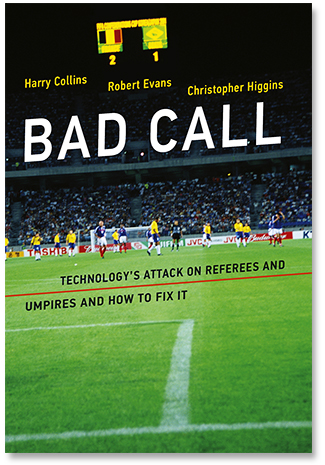Bad Call, book review: Science, accuracy and justice in sports decision-making


Bad Call: Technology's Attack on Referees and Umpires and How to Fix It • By Harry Collins, Robert Evans, and Christopher Higgins • MIT Press • 296 pages • ISBN: 978-0-262-03539-2 • £19.95/$26.95 (hardback)
What is the purpose of technological aids in sports? You're probably going to say accuracy, but in Bad Call, Cardiff professors Harry Collins and Robert Evans and PhD student Christopher Higgins make a persuasive case that instead it's justice -- for fans, as well as athletes, sponsors, promoters, and referees. We should, they write, resist the temptation to make accuracy a fetish.
The authors examine the use of technological aids in multiple sports -- primarily tennis, cricket and football (or soccer. The aids themselves range from traditional low-tech affairs, such as the bails in cricket, to the complex computer/camera systems the authors call 'track estimators' -- in cricket and tennis, that's Hawk-Eye.
Collins and Evans began studying track estimators in 2007, leading to a 2008 paper arguing that given their obvious errors sports authorities should not promote such devices as infallible but instead display a confidence level and margin of error. These systems could, they argued then as now, be used to improve the public understanding of science and uncertainty. Tennis's sharply rendered graphical image looks authoritative, with the result that many people, including commentators, fail to realize that they're seeing a virtual reality reconstruction of the ball's flight. If umpires and live spectators could compare to a TV replay, they'd see clearly that on occasion Hawk-Eye is wrong. Cricket, the authors argue, has done a much better job of assimilating Hawk-Eye into existing traditions and showing the technology's limits.
The authors' overall proposal is to adhere to the principle that the umpire is 'Right If Not Wrong' when adopting technological aids. That is, the umpire's right to create reality by adjudicating the play wins out unless they are unequivocally shown to be wrong. In a case where the tennis ball clips the back of the line and skids, line judge, players, audience, and viewers all may perceive it as OUT -- yet Hawk-Eye may still give it as IN. The authors believe justice for all concerned would be better served by allowing the umpire's call to stand when the ball lands within a margin of error, even if Hawkeye's recreated trajectory disagrees. That would be more like justice; what I love about this is they include fans among the stakeholders who deserve it.
High drama
The problem, of course, is that -- as the authors agree -- neither justice nor accuracy is necessarily the motivation for deploying these technologies. TV producers don't want the game held up, so tennis adopted it to end player arguments, framing Hawk-Eye challenges as high drama, with pulsing drum beats and (for indoor tournaments) suggestive lighting. The authors suggest that football and cricket borrow a technique from baseball, and pin a light on the field that's visible to all spectators to indicate that a play is being reviewed. The game continues without interruption unless the review shows that a mistake was made, in which case it's rolled back to that point and rerun -- much like reverting a computer to 'Last Known Good'.
The most important point the authors make, though, is this: they have struggled to get answers to many of their technical questions. Hawk-Eye Innovations regards this information as proprietary and confidential. Quite apart from the public interest in good science, given the massive public interest in sport, it seems entirely wrong that these systems are not completely transparent about such details as margin for error, camera frame rates, and so on. As the authors show, premier league championships have been won and lost on a single, erroneously-awarded point. And they are good enough scientists to fret about this, even when it's their favourite team that unfairly won.
Read more book reviews